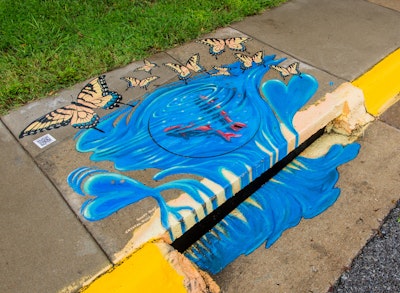
Interested in Stormwater?
Get Stormwater articles, news and videos right in your inbox! Sign up now.
Stormwater + Get AlertsAs associate director with the City of Fayetteville’s Department of Sustainability & Resilience, part of Leif Olson’s job is to pay attention to storm drains. He wants to keep pollutants out of the drains of this Arkansas community.
While Olson knows that whatever enters the drains flows to local streams and rivers, but most residents do not. That’s why Fayetteville and four other communities in northwest Arkansas joined the UpStream Art project, an innovative and creative way to educate the public about storm drains and stormwater runoff.
“Most people assume the water going into storm drains goes to a water treatment plant, but that’s not true. It goes right into local rivers and streams so any pollutants dumped into them easily find their way into local waterways,” says Jane Maginot, program associate for water quality with the University of Arkansas Division Agriculture Cooperative Extension Service and UpStream Art’s lead organizer.
UpStream Art was created in 2011 when 21 Municipal Separate Storm Sewer Systems (MS4s) jurisdictions came together to create the Northwest Arkansas Urban Stormwater Education Program. Together, they worked with the University of Arkansas Extension Service to provide the educational materials required by the Environmental Protection Agency to educate area residents.
As part of the educational component, each city pays a fee based on the population of their urbanized area. From there, a budget is created to provide the educational programs — including UpStream Art — to the 21 jurisdictions. Maginot says Upstream Art has become so large she has sought outside funding via grants from the Arkansas Environmental Association, Arkansas Natural Resources Commission and the Arkansas Arts Council. Each artist receives a stipend between $100 and $400. Besides the murals, funds are used to put together educational materials for area residents.
“The murals are pretty public art pieces that I hope stand as an educational tool, however, they are just jumping off points as an educational resource to catch people's attention,” Maginot says. “The brochures, calendars, social media and outreach programs are what make the project an effective tool for MS4 education.”
So far in 2015, the program has connected with 3,000 people through direct educational programing. Tens of thousands more are reached through media campaigns and social media, she adds.
In Fayetteville, Olson carefully chooses which stormwater drains are included in UpStream Art so the artwork — and its educational message — gets wide exposure.
“We try to target streets that get a lot of foot traffic and even did a drain on the University of Arkansas campus so people going there for football games would see it and maybe we would be able to educate more people,” he says.
Each of Fayetteville’s painted drains have a QR code on it so walkers can scan with their smartphones. The code links them to a website with educational information about storm drains and stormwater.
“The community has really embraced the project,” Olson says. “We always have plenty of artists submitting their ideas and since they are so great looking, there are even walking tours that show them off and educates people at the same time about what the storm drains do.”
Janet Paith, stormwater coordinator for the City of Bentonville, says that beyond UpStream Art’s educational component, it also brings visual art to area residents.
“We receive a lot of positive feedback from the murals,” she says. “People are surprised to see them and they really add to the community’s art environment. They also serve as a great tool in educating people where the water is going.”
The area’s rapid growth led to more pollutants finding their way into the local waterways, making it essential to educate community members about storm drains and what they do, Maginot says. The most common pollutants include sediment, yard waste, pet waste, litter and fertilizer from yards.
Besides Bentonville and Fayetteville, other cities taking part in UpStream Art include Bella Vista, Springdale and Rogers. There are 49 murals in total and new ones are created each year.
Shelli Kerr, Bentonville’s planning services manager, says artists are interested in participating in the program. She says it gives their work a lot of visibility.
“We look over the designs carefully and pick the ones we think are the best fit for the project,” she says.
Olson says more artists suggest ideas each year for the project.
“I just think UpStream Art is a great educational outreach program and teaches people about what storm drains do,” he says
On the Web
Learn more about Upstream Art at www.nwaupstreamart.com or follow the program on Twitter at @cleanwaternwa or Instagram at @upstream_art






